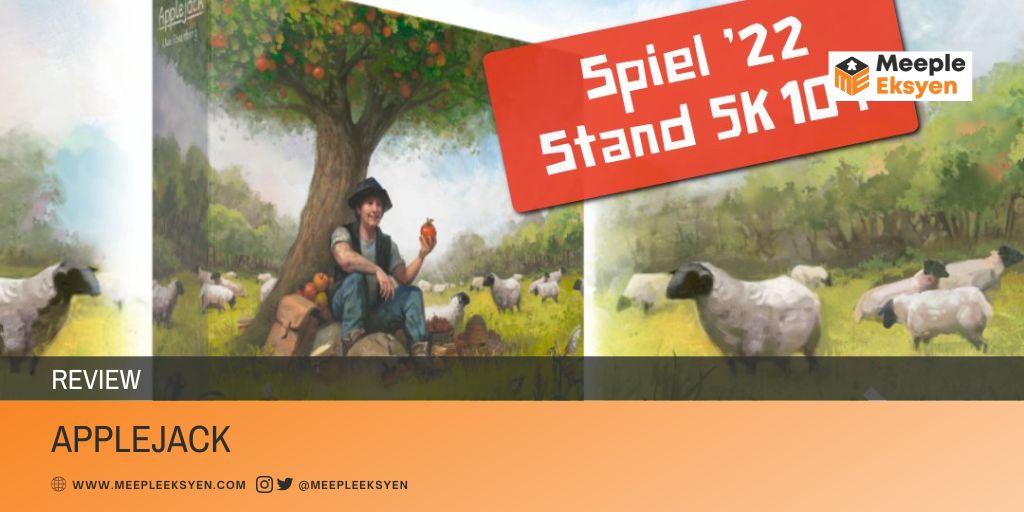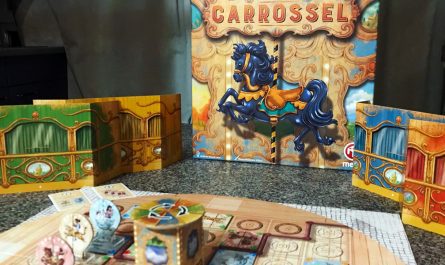Modern orchards nowadays comprise only a single variety of harvest, usually fruits. A monocropping, in its agriculture jargon. Biodiversity is an old farmers’ tale, so to speak. But that’s what we have now in our plate, as Applejack ushers a particular background story appertaining the not-so-modern apple plantation industry. It’s not two. Not even five. We’ll sow up to seven apple assortments.
A short disclaimer before you read my board game analysis
As an avid euro gamer and hardcore Legend of the Five Rings (L5R) LCG player, my reviews may reflect a preference for these styles, and I may not cover solo games/variants extensively. Please note that my personal remarks are based on my gaming experiences, and I aim to provide honest insights within the scope of my preferences.
An apple (jack) a day keeps the doctor away
This is not Uwe Rosenberg’s first piece that has an affinity to agriculture. But here’s the thing. His Agricola may not be a game for the fainted heart, and on the contrary, Applejack is milder than its predecessor. Complexity-wise, Uwe keeps his new game pretty modest this time. It’s a simpler game with tile-placement as the core mechanic. His solitaire board approach is similar to Nova Luna, another preceding game with the same apparatus. Both can be considered as puzzles, in a way. Smart ones, in fact, despite their shared simplicity.
Applejack is a Zen game. And just like Nova Luna, each player owns a player board, which depicts a solitary orchard. The only thing they all share together is the Harvest board. One common die acts as its tracker. It moves in a circular motion, which dispenses the active player a dilemma of choosing a hexagonal tile from two pitting troughs. Still akin to Nova Luna, which gives us an option to pick one out of three tiles along the track.
The similitude, however, ends there. Applejack is nowhere near the definition of reskin or re-theme. It still shepherds some new ideas to the table. Applejack is a whole new game from Uwe. So to speak. While Nova Luna practically presents itself somewhat as a race, where one game can abruptly end, the timing in Applejack is already pre-defined without any tension of beating the stint. As a solitaire game, Applejack really brings out more tranquillity. There is no such thing as a direct ‘take that’ in the separated orchards. The only way other players, or should I say other orchardists, to disrupt your field’s harmony is by taking the tree tiles you may require from the Harvest field. Otherwise, there is no other threat of road blocking and such. I’m looking at you, Carcassonne!
Peaceful. Yet, it still furnishes some thrill. Picking the tree tile means business, as there is neither redo nor substitution in doing so. Alas, there’s no such thing as a free lunch. The tree tiles, obviously, come with some cost. This aspect imposes more predicament than the selection of the tree tiles itself, as players need to efficiently plant those trees in their orchard, and manage their honey at the same time. The latter one becomes the currency of the game. It can be earned directly after placing a tree tile in the orchard, as long as two bee hives connect post-placement, reaping the lower number out of the two hives.
While it is tempting to have instant ‘money’ this way, it is nowhere sustainable. To limit the abuse, there’s a twist in this part. The honey a farmer receives is based on the lower number printed on those two connected bee hives. With that in mind, it also restricts players to casually take those hives with high numbers. Hence, as the game progresses, this way does not last long. Applejack carries some other ways to net some honey, too. Harvesting and Blossom. Albeit not instantly, both yield better output. It feels like managing an agricultural business, looking at the significance of picking the right plantlets and planting it in the limited 19-hexagon-space orchard. Additionally, extending the area where a variety groups together nets you more honey during the Harvest, and the final scoring.
Nevertheless, such investment demands more thinking. As the round goes on, the number on the die also increases. This imposes a sort of tax on all farmers, where they need to subtract their crop yield (up to three). Consider it like an increasing inflation. Thus, in the late game, they need to expand the group are for each variety, for each of them to keep bringing substantial earning. An area of at least four apples of that same colour is needed, if they want to cash out the end-game bonuses. That one is a hefty requirement, by the way.
It is, therefore, crucial to take the appropriate tree tile and place it correctly in the orchard. It keeps you from lacking of honey in your depot, and keeps you in the competition for bonuses. The former is proven to be disastrous. When one cannot afford to plant an apple tree, he or she shall pick a tree tile as usual and flip it, opening up a space for a pasture. It does net an easy two honey points, but at the cost of denying an opportunity to extend groupings of your apple variety. A rather costly move, if I may say.
Applejack requires considerable contemplative tile placements. It is crucial to envisage how my orchard would look like in the end-game, based on the available plantlets on the shared board. With only limited 19 spaces, I need to develop my apple business. And to constitute a profitable one, I must bed out the trees in a way to accommodate most of the seven varieties available. That’s a lot of work, perchance. This makes Applejack a clever puzzle game. One cannot just put his or her tree tiles randomly in the orchard, in the hope that it would just bloom and produce. Despite luck playing a role here, it’s pretty minor. I need to make do with whatever saplings the troughs provide.
Those limitations weigh and balance the multitude of choices to score points. Applejack creates tranquillity, true. Yet, it also enacts some subtle choice-makings throughout the game. I would not dare to say that it levies specialization to one of those scoring paths. That would be too farfetched. Yet, Applejack does force me to sometimes choose between two difficult options. Indeed, with seven apple varieties, bee hives, and the blossoms, sometimes I need to pick a path to score while sacrificing the other.
The solitary confinement of orchards means no meaningful player interaction in Applejack. With that aspect out of the equation, this game flourishes well, and playable, in any player count. It scales superb, I may say.
FINAL THOUGHTS
Applejack is, to bluntly say, more accessible than Uwe’s other agriculture pieces. It is a clever puzzle game. And it comes with hexagonal tiles. A decent artwork is another plus, too. The gameplay is simple, which easily penetrates any newcomers to try. It attracts broader audiences. Applejack ticks almost all aspects to get rated high, in terms of replay value. Short time to set up, easy-to-understand rules, and a gameplay scaling well with any number of players, it may be alluring to get it back to the table more often.
As a Zen game, Applejack brings out the cordial atmosphere of agriculture fields. Untouched by conflicts. It may be too peaceful for gamers longing for higher player interaction.
Do you love board games as much as we do? Support us!
Thank you for reading our articles! If you enjoyed our work and want more captivating board game contents, make sure to:
👉 Follow us on our social media — you can find us on ![]()
![]()
![]() Click one of the icons to land on our social media, or find us @meepleeksyen there, it’s just a click away! Stay updated with our latest board game reviews and previews by following us on those platforms 📱👍
Click one of the icons to land on our social media, or find us @meepleeksyen there, it’s just a click away! Stay updated with our latest board game reviews and previews by following us on those platforms 📱👍
💬 Do you have contrasting opinions? Leave a comment — share your thoughts with us, we’d love to hear (or read) yours! Have you played this game before? Did you have something similar as well? Or perhaps, something more personal, like what are your favourite board games? Let’s discuss in the comments below!
🙏 Support Us! Your generous support can help us produce even better content in the future. If you love what we do, consider making a donation to our blog. Every contribution counts and means a lot to us! You can either donate locally with Indonesian Rupiah (IDR) via Trakteer ![]() or for international readers with another currency through Buy Me a Coffee
or for international readers with another currency through Buy Me a Coffee ![]() It helps us to survive, too! 💰 Click one of the button below 👇
It helps us to survive, too! 💰 Click one of the button below 👇
I am a full-time food technologist during weekdays. However, when the calendar hits weekends, I transform into an avid board gamer. I am a hardcore Legend of the Five Rings (L5R) LCG player from Fantasy Flight Games (FFG). Current hobby: buying board games. My shelf of shame’s list is getting longer, thanks to you, Kickstarter.





